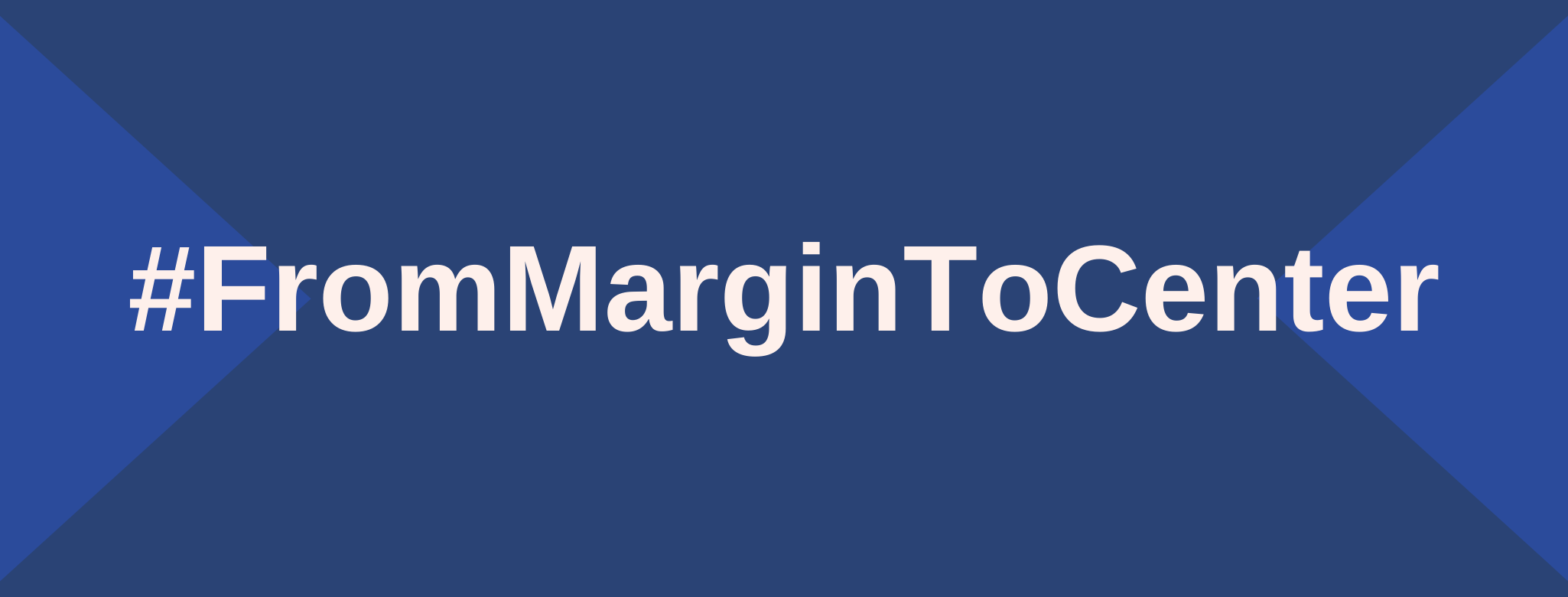
#FromMarginToCenter is born out of the clear need to draw attention to marginalized voices, not only across our society, but specifically in our library. We need to acknowledge that nondominant experiences are not well represented in our collections and resources, and further we need to do something about it. Traditional cataloging and classification practices in libraries have reified existing power structures through persistence of naming conventions (an example drawn from Library of Congress Subject Headings: “Illegal alien,” a subject heading still being used to refer to undocumented immigrants, for example) and through classification schemes (Another example from the Library of Congress Classification Scheme: N6538.N5 Visual arts. History. Modern art. Negroes. African Americans. Blacks.). Meanwhile, one of our most frequent inquiries from students is to see examples of work by artists and designers of BIPOC, queer, and other marginalized identities. As a library, we need to achieve a balance between highlighting work from those creators, while not contributing to further marginalization by inadvertently segmenting them off to their own groups, nor oversimplifying their experiences by forgetting the foundationally intersectional characteristics of identity. To center the marginalized, without further marginalization, is the task we seek to accomplish in this initiative.
bell hooks, influential theorist across feminist and African American studies, discusses the dualistic tug between margin and center this way:
To be in the margin is to be part of the whole but outside the main body… Living as we did–on the edge–we developed a particular way of seeing reality. We looked both from the outside in and from the inside out. We focused our attention on the center as well as on the margin. We understood both. This mode of seeing reminded us of the existence of a whole universe, a main body made up of both margin and center. Our survival depended on an ongoing public awareness of the separation between margin and center and an ongoing private acknowledgement that we were a necessary, vital part of that whole. hooks, Feminist Theory: From Margin to Center (Cambridge, MA: South End Press; 2000): xvi.
The library seeks to change its scope to be more representative of the “whole universe” as hooks calls it, by calling attention to the margins as a public “acknowledgement that [they] are a necessary, vital part of that whole.” Drawing inspiration from hooks’ words and actions for #FromMarginToCenter, our strategy is as follows:
- Create a growing body of resources designed to highlight contemporary artists and designers across a broad range of identities. Our selection criteria combine staff expertise and interest, current events, and providing a balanced range of resources, knowing that this is an emerging body of material that will evolve and take different shapes over time.
- After putting in the work to create a resource guide, we amplify those voices. We highlight specific creators in our social media, look for ways to collect more material about or by the person in question, and find ways to embed references to these folks in our more general use guides, as well as our teaching, outreach, reference, and other activities.
Through doing so, we can offer a balanced set of actions that both highlight marginalized while reducing any inadvertent marginalization.
#FromMarginToCenter Guides created thus far
- Afro Caribbean Art
- Afrocentric Architecture *
- Asian American Artists, Designers, and Architects *
- Black Artists & Designers
- Disability and Art
- Inclusive Design
- Contemporary Latin American Artists
- Pan-Africanism in Art and Literature
- Women-led Architecture Firms
- Indigenous Art & Architecture
Coming soon:
- Queer Architect(ure)s
* denotes guides specifically requested by our patrons.
Please let us know what you think. You can either email us at rickerlibrary@library.illinois.edu, or give us feedback anonymously via this form.
Further Resources
Want to read more about efforts like these across libraries and librarianship? Here’s a couple resources to check out:
- Sara A. Howard and Steven A. Knowlton, “Browsing through Bias: The Library of Congress Classification and Subject Headings for African American Studies and LGBTQIA Studies.” Library Trends 67, no. 1, 2018 (“Race and Ethnicity in Library and Information Science: An Update,” edited by Nicole A. Cooke), pp. 74–88.
- Amanda Ros, “The bias hiding in your library,” The Conversation, March 20, 2019 https://theconversation.com/the-bias-hiding-in-your-library-111951
- Melissa Adler, Jeffrey T. Huber, and A. Tyler Nix, “Stigmatizing Disability: Library Classifications and the Marking and Marginalization of Books about People with Disabilities,” The Library Quarterly 87, no. 2 (April 2017): 117-135.
- Michelle Caswell, “Teaching to Dismantle White Supremacy in Archives,” The Library Quarterly 87, no. 3 (July 2017): 222-235.
- Emily Drabinski, “Queering the Catalog: Queer Theory and the Politics of Correction,” The Library Quarterly 83, no. 2 (April 2013): 94-111.
- Change the Subject, Directors Sawyer Broadley & Jill Baron, 2019. https://www.pbs.org/video/change-the-subject-23nbpj/